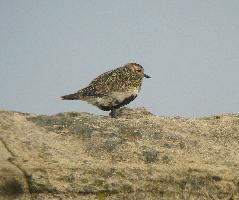
Váhy a míry
| Délka | od 14 do 17 cm |
|---|---|
| Hmotnost | od 25 do 55 g |
| Délka rozpětí křídel | od 42 do 48 cm |
Biologická data
| Délka života | 4 r |
|---|
Popis zvířete
The Little ringed plover (Charadrius dubius) is a small, charming bird that is a member of the plover family, widely recognized for its distinctive appearance and intriguing behaviors. This bird species is notable for its compact size, with a body length typically ranging between 14 to 18 centimeters, and a wingspan that spans approximately 35 to 57 centimeters, making it one of the smaller members within its family.One of the most striking features of the Little ringed plover is its plumage. The bird exhibits a beautiful contrast of colors, with the upper parts of its body showcasing a sandy brown or grayish-brown color that blends seamlessly into its natural habitats, which include riverbanks, gravel pits, and lakeshores. The underparts are predominantly white, providing a stark contrast to the darker upper body. A distinctive black band runs across the chest, a characteristic feature during the breeding season which helps in distinguishing it from similar species.
The face of the Little ringed plover is adorned with striking markings that captivate the attention of birdwatchers. It has a prominent white forehead, bordered by a black band that extends through the eyes, creating a mask-like effect. The eyes themselves are noteworthy, featuring a bright, golden-yellow iris encircled by a vivid yellow eye-ring, which is especially pronounced during the breeding season and serves as a distinguishing feature from the closely related Ringed plover.
One of the most endearing behaviors of the Little ringed plover is its nesting strategy. The bird lays its eggs in a simple scrape on the ground, often in gravelly or sandy areas, which provides camouflage for the eggs and chicks. The nests are minimalistic, sometimes lined with small stones or shell fragments. Both parents share the responsibility of incubating the eggs and protecting the nest, demonstrating a strong parental investment in the survival of their offspring.
The diet of the Little ringed plover primarily consists of insects, worms, and other small invertebrates, which it skillfully hunts using a characteristic "run-and-pause" technique. This hunting method involves the bird running rapidly across the ground, pausing abruptly to scan for prey, and then darting forward to snatch it up with its sharp beak.
The Little ringed plover is a migratory species, with birds breeding in Europe and parts of Asia, and wintering in Africa and southern Asia. This migratory pattern highlights the bird's adaptability and resilience, navigating vast distances across continents in search of suitable habitats.
Despite its widespread distribution, the Little ringed plover faces threats from habitat destruction and disturbance, especially in areas where human activity encroaches upon its breeding and feeding grounds. Conservation efforts are essential to ensure the preservation of this species and its habitats, allowing future generations to continue enjoying the sight of these delightful birds.
In summary, the Little ringed plover is a fascinating bird that captivates observers with its striking appearance, intriguing behaviors, and remarkable life cycle. Its presence enriches the ecosystems it inhabits, making it a cherished member of the avian world.
Podobná zvířata
Nové fotografie zvířat
Top 10 zvířat
- Dolphin gull (Leucophaeus scoresbii)
- Diana monkey (Cercopithecus diana)
- Moustached guenon (Cercopithecus cephus)
- Galápagos tortoise (Geochelone nigra complex)
- Japanese macaque (Macaca fuscata)
- Stone loach (Barbatula barbatula)
- Russian tortoise (Testudo horsfieldii)
- Greek tortoise (Testudo graeca)
- Common flying dragon (Draco volans)
- Vendace (Coregonus albula)


